the first images of the concerts of Charles Curtis, Mika Vainio and Lucio Capece. 4 October 2007, Argos Brussels. Co-production with QO-2
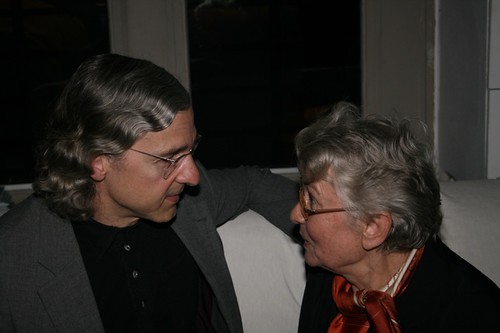
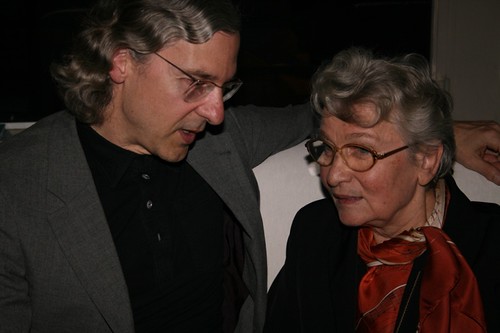
Charles Curtis and Eliane Radigue before the concert
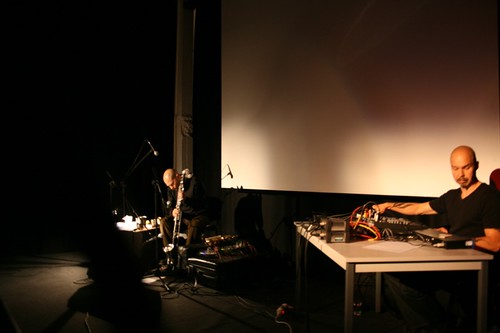
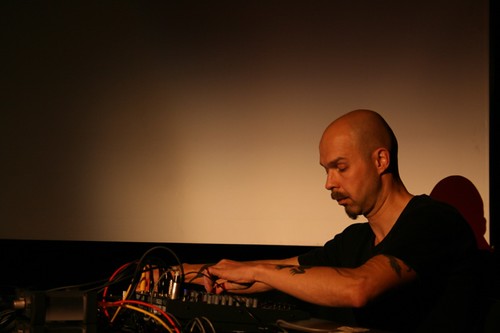
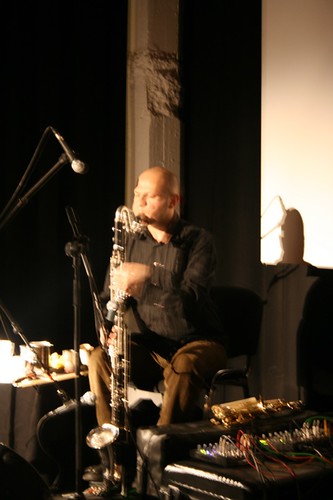
Lucio Capece and Mika Vainio
the first images of the concerts of Charles Curtis, Mika Vainio and Lucio Capece. 4 October 2007, Argos Brussels. Co-production with QO-2


Charles Curtis and Eliane Radigue before the concert



Lucio Capece and Mika Vainio
5 October 2007, Argos Brussels. Co-production with Institute of Network Cultures.
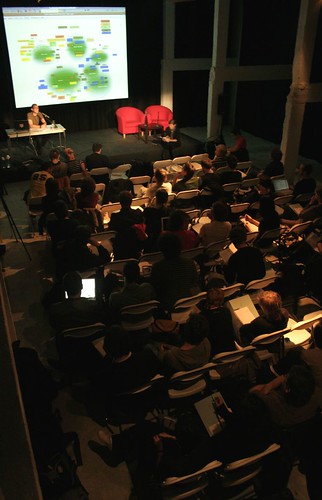
the audience
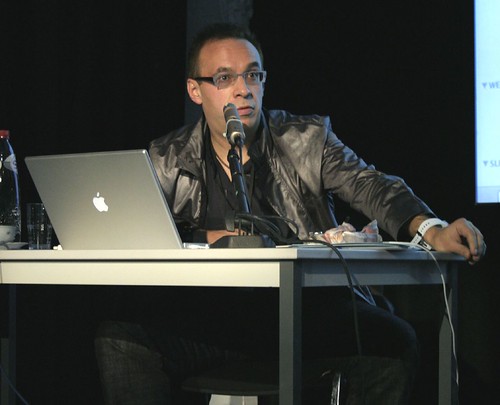
Lev Manovich
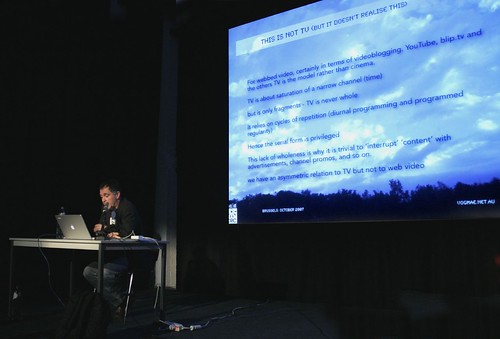
Adrian Miles
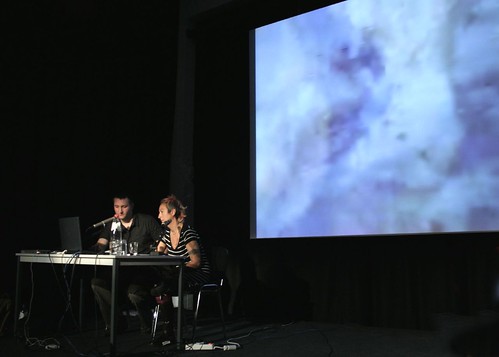
Tomas Rawlings & Ana Kronschnabl
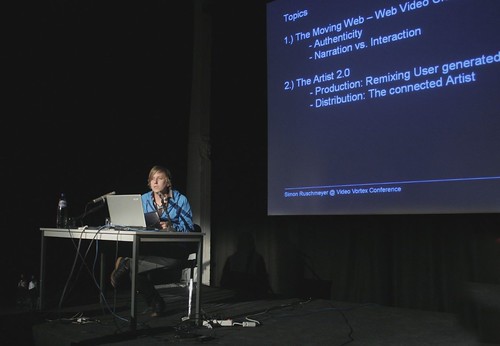
Simon Ruschmeyer
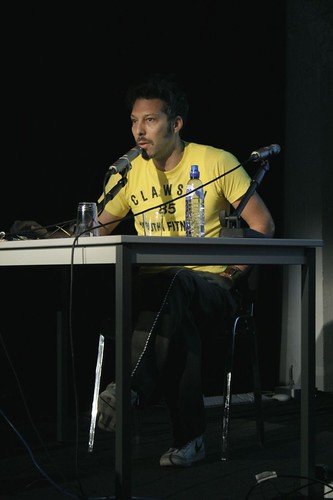
Peter Horvath
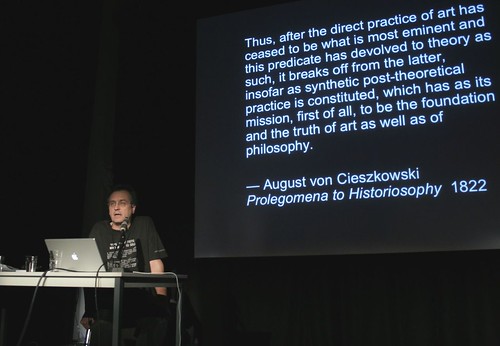
Keith Sanborn
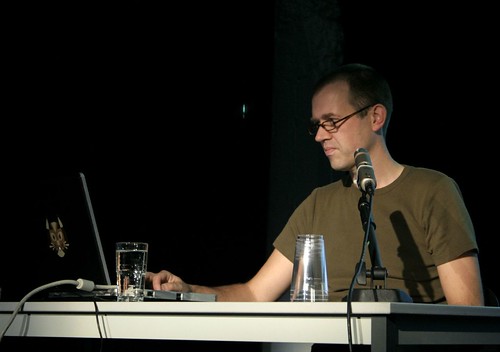
Peter Westenberg
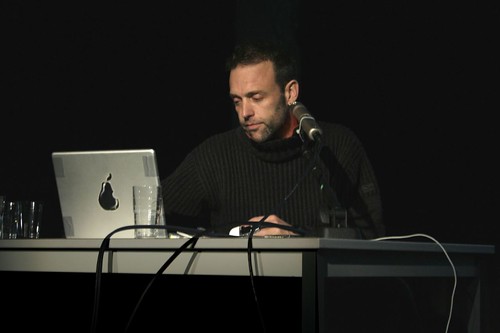
Johan Grimonprez
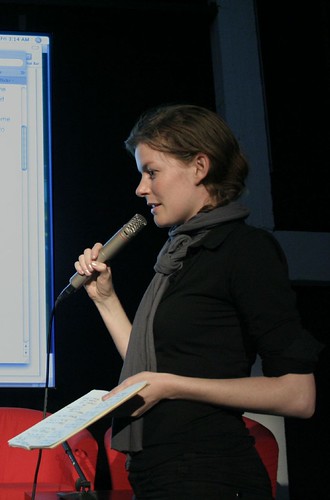
Sabine Niederer – Moderator Video Vortex
More stuff soon here
6 october 2007, Argos Brussels. Co-production with PACKED.
written by Barbara Dierickx
Moderator Marleen Wynants opened the ‘Media, Memory & The Archive’ conference by telling a little anecdote: “Instead of ‘Is this computer switched on?’, the first question of the day was ‘Is this conference being taped?’”. This question immediately set the tone: throughout the day, preservation and conservation were prominently present concepts.
The first person to lecture was Richard Rinehart. He discussed the relationship between new media and social memory. This kind of memory can be stored both on a social and formal level (in musea) or in informal ways (through a fanbase on the internet). Rinehart would like to see a concept of archiving in which preservation means ‘move-age’ and not just ‘storage’. A work of (new) media art doesn’t ‘die’ when it is kept in constant circulation in electronic wires, instead of being stored on a hard disk.
This thesis brings along some questions of technology and original artistic intention. To overcome these two problematic issues, Rinehart proposes the development of metadata, tools and specific projects. The concept of metadata was very well illustrated by Rinehart’s research concerning the MANS (Media Art Notation System). In the same way a musical score contains the integrity of the (musical) piece, Rinehart would like to develop a ‘code’ of soft- and hardware processes, used in the work one wants to preserve. This actually is still a theoretical model, since the code is in this stage of development too much tied to contemporary electronics standards and hasn’t been materialised for a specific preservation case. Richard Rinehart is currently working on three different tools; the FFDB, DAM (Digital Asset Management) and VMQ (Variable Media Questionnaire). A preservation project Rinehart referred to was the ‘Open Museum’ at Berkeley; the creation of an open source archive, applied to the fine arts and museum context (for the first time).
Rinehart’s vision on preservation is one of change over fixing and behaviour over phenomena. To conclude, he compared the data to be preserved with butterflies: “Musea should not only be pinned-down etymology cases but butterfly huts”. This statement would resonate throughout the whole conference day.
Oliver Grau linked his ideas about media art conservation to a project in which he is involved, the ‘Database of Virtual Art’ (DVA). Since only a very little part of the digital art spectrum makes its way to the museum, we witness the erasure of a significant part of those works. The DVA tries to ‘save’ some artists’ work from deteriorating but according to Grau, media art cannot be fully understood without knowledge about its own history. With the ‘Re:Place’ conference and his book ‘MediaArtHistories’, Grau tried to provide this basis. He also blames this lack of historic knowledge for the malfunctioning cultural policies on the topic of new media art (and its preservation).
The DVA itself is a ‘Dspace-based’ website where the artists themselves can upload information about exhibitions, (specificities of) the work, etc. Selection of artist and academic members is based on the approval of members from the DVA advisory board. During the lecture, the question of ‘quality’ as selection standard was questioned, but Oliver Grau was convinced of the fact that this was taken into consideration during the ‘approval’ selections. The DVA incorporates a broadly structured search function, featuring a thesaurus based on the Getty one, interviews with artists and so on. The data these interviews deliver are in their turn used to improve academic research on the topic through the ‘Master of Arts in MediaArtHistories’ programme, where – amongst others – Lev Manovich lectures.
Oliver Grau stressed the need for change in the cultural policy of mainstream institutions; as long as there is no international funding, North-American and European projects on media art conservation will continue to operate on different levels; no strategic alliance of f.e. the library world can come out of this unless the problem gets solved.
Charlie Gere had an image of the ‘Biomorph’ software projected behind him during his lecture which mainly discussed the Richard Dawkins book ‘The Blind Watchmaker’ and its relation to preservation. Dawkins speaks in his book of the DNA as being like an archive; this has been a quote with great success. An archive is indeed a bit like genetics.
Biomorph is an application that demonstrates very effectively how random mutation followed by non-random selection can lead to interesting, complex forms. These forms are called ‘biomorphs’ (a word invented by Desmond Morris) and are visual representations of a set of ‘genes’. In relation to this, Charlie Gere quoted Derrida and his idea of deconstruction. Nevertheless, the body of Gere’s lecture consisted out of reflections on Dawkins’ book.
Considering the archive, Gere mentioned that categorising always happens after the event. The true ‘meaning’ of an archive can only reveal itself in the future. Over an evolving period of time, evolution and hybridity of means will occur. Because of that, different meanings rise according to different context in which they are analysed. Therefore, the archive carries in it a promise of the future itself and its meaning will change over time.
Wolfgang Ernst entitled his presentation ‘Archives in Transition’. As an example of the restoration of moving images, he used the Baird-reconstructed piece of early broadcast television from transdiffusion.org. The computer is becoming the media archaeologist itself because it is the “only one able to read and restore the data”.
In the early media days, people were used to fixed inscriptions in the material like f.e. the needle that cruises on a record. Electronic media use electronic signals on which they store their data. Both of them represent a radical technical rupture and two different types of storage devices. Ernst explained that because of those new forms, new archival dynamics did arise. They didn’t have to be space-orientated anymore but rather time-orientated. Archives should become time-critical as well: is read-only storage still sufficient to the user? Dynamic memories require archives that are productive and focussed on immediate reusability of their content. This way an archive is rather located in the present than in the past: “It moves or it becomes a piece of furniture”.
Ernst attributed a powerful role to the computer in the future of archiving. What once was physically real on a record, is now physically real in PC numbers. Memory increasingly becomes mathematics and this is an often neglected evolution in archiving. Library catalogues still operate on a symbolic level (as we type in letters); the computer memory resembles much more the structure of the brain memory according to Ernst: “Archival fields replace the idea of the classificatory system of the library”.
In conclusion, Wolfgang Ernst stated a provocative “The term ‘archive’ is becoming a hindrance”.
Josephine Bosma discussed some issues entitled ‘The Unstable Archive: Art Preservation and The Vanishing Museum’. The museum doesn’t seem to have the presentation of art works as it’s most pressing issue or core business at this very moment. If even present at all, new media art presentation stays very superficial. We are trying to lock away these new unstable arts into old archives (of stable arts). A re-identifying of the museum urges itself, perhaps linked to the questions what art to purchase and what art to preserve at all.
Bosma brings up the ever changing and increasing participatory role of the audience in new media art. Boundaries between cool shops and art galleries are blurring, artists can not go home on opening nights of their exhibition because the audience involvement ‘completes’ their work. How can this be archived? Technology isn’t that much of a problem, changing a whole ‘archival mindset’ is much more of a difficult topic. Digital art, new media art and net art are used throughout one another; a clarification in vocabulary would in this respect be a good starting point.
In the last part of her lecture, Josephine Bosma referred to Boris Groys and his ‘Logik der Sammlung’: “An archive represents continuation” (an idea which, launched by Richard Rinehart, passed by regularly by at this conference). The curator however, described by Bosma as ‘Artist Curator Archivist’, is nowadays supposed to be a technical assistant, web expert and so on. These are qualities never demanded by other arts; Bosma stresses that curating should be curating – period, and other functions should be executed by (respected) experts in order to achieve a decent archive.
Jean-François Blanchette was ‘Waging the Technological War on Oblivion’. What if you never forgot anything? But is forgetting really such a bad thing? Digital archives tend to be seen as ‘pure’, because data are not hindered by an ever growing materialisation on paper. It’s the myth of ultimate transparence. Blanchette illustrated this by a Microsoft’s Gordon Bell picture; Bell wanted to remember his whole life through digital archived information about it.
Blanchette soon switched to a very important and often overlooked aspect of remembering and conservation. Interpretative frameworks are what allow us to re-interpretate a work of art over an indefinite period of time. We are still able to read Aristotle’s writing because each generation made its own interpretation of the work and passed it on. The preserving of intelligibility is crucial. Who is responsible for this? The archivist and curator. By maintaining cultural activities around the content (through exhibitions, giving access to researchers, etc.) they are keeping the preserved material alive. Users in their turn can create new relevant knowledge about it or create new derivate works. “The digital archivist must preserve information and knowledge; not only just the (electronic) bits by transforming the content and enriching it to preserve its intelligibility”.
Blanchette illustrated this with his Mustica model. Very much like Richard Rinehart’s MANS, this model is now used for the preservation of musical works. How to archive all the concepts of a live performance in order to recreate it later? I will not go into the model in detail here, but it can be visited at ircam.fr. Documented elements of a performance can include performance guidelines, stage-setting, used instruments and even the flyer of the performance date. In preserving, Blanchette stated, we do not only have to conserve the physical artefacts, but also the ability to re-create by preserving implicit knowledge from f.e. instrument makers and performers/artists themselves.
Steve Dietz, like Manovich earlier, also called for a new set of tools for measuring cultural life in a more adequate way. Entitled ‘The Archive as Rescension’, he clarified in his presentation that there can not be any hierarchy of versions (of artworks) that act as ‘replacements’ of earlier versions of the work. Dietz’s lecture was illustrated by the Walker Art Centre’s Adaweb. One of the works there was recently upgraded to become compatible with newer Flash versions. Conserving is adapting, moving, re-thinking. The bigger part of his lecture was packed with examples of new forms of archiving like f.e. Pablo Helguera’s ‘Memory Theatre’ (2004) and Dietz’s own databaseimaginary.banff.org.
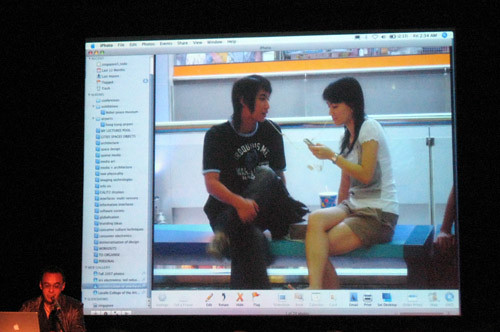
The two conferences, ‘Video Vortex’ on friday 5 October, and ‘Media, memory and the Archive’ on Saturday 6 October went very well, thanks to the Argos personnel (some of them have been fired a few months ago – due to several ambiguous and crappy reasons I will not go into now – but kept on working at full force! We owe you a lot … You know who you are), interns and volunteers, and of course the great bunch of speakers and audience members. We hope you all had a good and interesting time.
We will post all pictures and video material online in a few days, but in the meantime, this is a first report, written by Barbara Dierickx. Thanks!
btw the picture of Lev Manovich is taken by “Silvertje” (Flickr name) one of the bloggers who documented the event. Anne Helmond wrote something on Lev’s talk, and Adrian Miles posted an interview he did with Jan de Pauw as an MP3)
In his introduction at the first Video Vortex conference, Geert Lovink made it clear that the subtitle ‘Responses to YouTube’, was not to be taken literally. YouTube was throughout this conference presented as a metaphore for other net-based communities like Flickr or Myspace. “Nevertheless, YouTube is a killer application. While a few years ago the music industry encountered a ‘Napsterisation’ of their business, the same is happening to the present video industry.” With the rise of user-generated content in peer-to-peer networks, Lovink wondered whether the database was becoming a new social form. There couldn’t have been a better link towards the first speaker of the day.
Lev Manovich made a plea for the development of new tools, created to measure and analyse the ever increasing online participatory culture. With consumer numbers continuously rising, ‘statistics’ seem the pefect answer – though they are meaningless without a proper contextualisation. The intention of Flickr-posters can not be derived from a list of statistics. Not all content that makes its way to the net was initially intended for wide distribution. Software industry and the developments in consumer electronics push us to share videos and post responses and thus provoke new social media behaviours. “You don’t just watch, you have to create it yourself”. Are we witnessing an increasing participatory culture or the birth of the ‘culture industry 2.0’?
Manovich aims to develop a ‘quantitative analysis of culture’ which will allow us to adequately analyze global culture and for instance its growing number of professional users. We see a large number of smaller cultural players take over from the masters of industry. Manovich illustrated his point of ‘scaling up’ with the ‘IBM History Flow Research’: what if data about the visiting frequency of a certain website could be measured for a multitude of those sites? It could render us a more adequate cultural analysis and possible visualization of this Web 2.0. Yet, to conclude, Manovich announced that these ‘software-based theoretical tools’ are not the answer; they are an alternative.
Next up was Adrian Miles. He discussed the term ‘softvideo’, as being an open form of video distribution. “What is video when we move (it) to the web?” In his theory, Miles often refers to Gilles Deleuze and his writings about cinema; more specific the relationship between shots and editing. Films are made of small parts; shots are only fragments. They are what make video and cinema. In this context, Miles uses the term ‘granularity’; the breakdown of the ‘whole’ of the film to its basic grains. Softvideo and its crystalline structure try to loosen up the tying down of these bits by traditional cinema. In editing, you produce the external relation between the shots, which can be multiple and based on narrative, colour, action and others – while in traditional video this ‘multiple’ becomes ‘single’: one choice in editing is made, f.e. based on colour, to improve the beauty of the final piece. Since softvideo has no narrative timeline, it lends itself to more musical of poetic forms. Its crystalline facets allow the establishing of multiple relations, by each shot having a view towards its others.
YouTube and other online video applications are often characterised as ‘Web 2.0 technology’ but in terms of webbed video they are more ‘Video 1’: their minimal unit is the whole video, which is way too large a ‘unit’.
Ana Kronschnabl & Tomas Rawlings are both active core members of the website plugincinema.com, acclaimed forum for all Internet filmmakers. Plugincinema.com aims to offer an all-including framework for filmmakers using digital technology. The site is dedicated to the creation and distribution of on-line films, and has outspoken didactic intentions. At the conference, Kronschnabl and Rawlings laid their ‘Pluginmanifesto’, a set of guidelines for online filmmaking, over the YouTube model. The next proposals come from their manifesto: “A film made for viewing on the Internet is not 1_ hours long, it doesn’t have to have a narrative – structure can come from a variety of means.” YouTube videos are posted for a variety of reasons, not all of them are therefore stories with a beginning and an end. “Use Codecs and compression creatively.” This was illustrated by a video from Ana herself, shot in _ pixilation. “Filmmakers and Geeks should be friends.” When talking about the ‘geeks’, Kronschnabl and Rawlings stressed the fact that YouTube is far more utilitarian than earlier videosites like IFilm: one had to choose a certain softwareplayer, all YouTube aks you to do is press the ‘play’ button. “Never forget the medium and the viewing context.” On YouTube you see without any context: raw footage stands next to homevideo’s, video series developed only for the platform, video diary, essays, …
Kronschnabl and Rawlings also addressed the question of YouTube’s future evolutions. Possibilities according to them were the ability to search within the video itself (illustrated by a ‘Blikx’ demo), augmented reality (f.e. Sony’s ‘Eye of Judgement’) and separation of content and platform through f.e. mobile phone browsing. To conclude, the film ‘Distance Over Time’ was shown, which originated out of the manifesto-rules.
Peter Horvath later talked about the progression of technology and how this impacted the stories he wanted to tell as a net artist. The main focus of his lecture was on the presentation of his own artwork, featured on his website 6168.org. Horvath presented ‘The Presence of Absence’, a creation for the Whitney Artport. In this work, he often uses pop-ups to create a continuous cinematic experience because several windows play video at the same time, instead of the classical load-start-stop pattern. An explanation about the navigation on the net-based work is never given; the users have to figure this out for themselves. Because of the high level of technology involved in these works, Horvath has to let go a part of the control over the actual presentation: he is not aware of the technical configurations of the viewer’s own computer (are there for instance pop-up blockers?) and therefore he can not know how the art will look in the end. Other works by Peter Horvath shown at Video Vortex were ‘The Wartime Project’ (2003) and ‘Tenderly Yours’ (2005). His work is an example of web-based art which is deteriorating due to evolutions in pc-software. The example was given of certain browser functions that do not operate anymore and therefore are unable to display the artwork as it was meant to be displayed.
Simon Rushmeyer’s presentation was entitled ‘The artist moving (through) the Web’. It discussed new forms of artist production and distribution on the internet, as illustrated by YouTube. Rushmeyer’s first point was that of the authenticity which is provoked by many YouTube videos. People dancing in their bedroom while the camera is running, directly addressing the camera as they speak, shaking the camera as they walk. All these aspects, when seen in a video, provoke a feeling of authenticity. Rushmeyer discussed the hidden agenda of some of these videos like Lonelygirl15 and the Mark Ecko Viral Clips Series – driven by marketing they provoke an authenticity that’s completely fake.
‘The database’ also made its way in Rushmeyer’s presentation; in a ‘network narrative environment’, the database meets personal stories and information. This was illustrated by the ‘Photosynth Tech Preview’. Other examples of the YouTube-isation of the Web were given: user-generated content gets remixed by professional artists (‘Driving’, by Marc Christian Schmidt), full feature films get developed for Second Life and YouTube only. This last example, entitled ‘Four-eyed Monsters’, shows the active role of the audience in the development of these kinds of projects; the ‘active’ consumer/creator becomes a member of a special interest community and, in the end, gets to see his favourite internetmovie – via ‘critical mass ticketing’ – in a real-life theatre nearby.
Peter Westerberg started of by presenting a map he had created on the decisionmaking in the project/process of videomaking. This checklist of the video workflow, based on his own working principles, was centred around five core ‘tasks’: video-input, capture/digitisation, export videofile, editing and distribution. This distribution was then linked to online platforms for distribution of video. These had, according to Westerberg, three prerequisites. Such platform should facilitate the exchange of video to people who share the same interests. It should provide a legal framework in which issues about copyrights can be cleared. Last, is should enable artists to share their work (in) process.
Westerberg pointed out to important aspects in realising this: open source software (such as KINO, an open source edit tool) and money. The latter was illustrated by aswarmofangels.com and a Chad Hurley video on moneymaking (the irony).
One of the crucial aspects online distribution platforms have to deal with, remain copyrights. Westerberg warned about the right f.e. YouTube attributes itself; they can change the terms of license anytime they want, after you’ve signed them, and without notice. The control over own material, posted on distribution platforms is – as was pointed out – not always very easy to keep in your own hands.
Keith Sanborn started of by showing the YouTube version of his piece ‘The Artwork in the Age of its Mechanical Reproducibility by Walter Benjamin as told to Keith Sanborn’. Sanborn mostly talked about his video-installation ‘Equivalences’, which could be visited as part of the ‘Black September’ exposition at Monty (Antwerp). He explained how each part of the work was constructed in the space of Monty and which video-elements he combined together. Examples of combinations were an image of Lenin with moving video of a girl getting a present and hysterically crying that “she had one”, a drunk Kate Moss dancing next to Saddam Hussein’s execution, Miss Teen South Carolina ‘lost for words’ and texts by Walter Benjamin himself.
The last guest at the Video Vortex conference was Johan Grimonprez. He discussed both his projects ‘You-Tube-o-thèque’ and ‘Zapomatik’. Grimonprez could be considered ‘YouTube curator’, hence he showed some of the YouTube video’s that struck him during his research.
The construction of media and politics was shown in ‘Making Up The President’, ‘Echolalia’ presented the hollow words of the Bush jr. apparatus, the Dove-ethos was being made into a parody, and so on. Politics never seem far away in Grimonprez’ work, and this also goes for the Zapomatik project. The history of the remote control and television walks side by side with the race for space and the cold war. YouTube and its ever higher levels of possible interactivity reflect onto the remote control itself: it becomes more and more an outdated object. Manual choosing became replaced with navigating on interactive DVD menu’s.

Tony Conrad (One of the pioneers of structural filmmaking, video art, and minimalist music) is coming to Brussels, and what’s more, he’s playing, for the first time in Europe, a re-worked version of his Ten Years Alive on the Infinite Plain (1972). This “minimalist spectacle” features a projected film loop of black and white images, alongside a stellar group of string players. Earlier versions of this performance featured musicians like Jim O’Rourke (in The Kitchen, NY), but also Mick “Mike” Flower (of Vibracathedral Orchestra), Angharad Davies and Ryoko Kuwajima (at Leeds City Art Gallery, UK on Monday 3rd April 2006 – see this video for an example):
While this performance will take place at Bozar on Saturday, the day after he’s doing a performance/screening/lecture at Argos. We don’t really know what to expect (he will probably present and talk about a range of films and videos), but this video might give you a lead, it’s part of a lecture he did a few years in Brussels.
Tony’s home page
interview with Tony Conrad

Some more info on the performance (this was in a mail he sent us):
Forty-five Years on the Infinite Plain (1972-2007)
A work that relates to time but exists independent of points in time refers to the obverse side of time, beyond the possibility of measuring it with markings: duration. Yet unmeasured duration, in principle, is a kingdom entirely at the command of the recipient and his or her subjectivity.
Diedrich Diedrichsen, Time and Dream: Tony Conrad’s “Yellow Movies”
Ten Years Alive on the Infinite Plain (1972), like some other works of the psychedelic era, commingles starkly formal abstraction with introspective romanticism. Its insistent conflation of quasi-religious spectacle with materialist minimalism follows a path marked out by Rothko, Cage, Andre, and many others. Today these elements have lost their radicalism; even the political conviction of that time, that such work could make contact, through its spiritual insistence, “with the political real behind the culture of commodity and spectacle” (as Diedrichsen puts it), seems problematic and thin.
In revising “Ten” to “Forty-five”, I am addressing a broader chronological perspective, relocating to a different social allegory, and accessing the plural tools that encompass a more contemporary “minimalism.” The “subject”—that is, the viewer—is still at the center of the work; but now the polyvalence of subjectivity is recognized in a figural usage of heterophony and antiphony. A solo cello challenges the lead instrument, and the audience area is divided in half. Musical figures invoke divisiveness, over the unitary ground of the drone. There are two distinct rhythms to follow, further dividing the subject’s attention.
These elements of what would have been seen in 1972 as “confusion” instead, in today’s heterotopia, reflect and invite access to a subjectivity that is more “true to life,” more centered on the plain where we stand.
As indicated below, this piece will require five local performers and a local projectionist, in addition to Tony Conrad and MV Carbon (she’s, amongst other things, a member of Metalux! Huurah!). The performance itself will last about 95 minutes.
Music ensemble 1:
Long string instrument
Violin (Tony Conrad)
Viola or cello drone
Bass (acoustic bass or bass guitar)
Music ensemble 2:
Cello with reel-to-reel tape recorder and electronics (MV Carbon)
Violin drone
Violin or Viola drone
Bass (acoustic bass or bass guitar)
Projectionist (four projectors with loops)
The Participants will be Julia Eckhardt, Stefaan Quix, Timo van Luyck, Stefaan Smagghe, Jürgen De Blonde, Dominica Eyckmans and Els van Riel. Huurah!